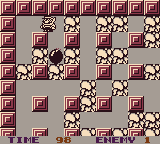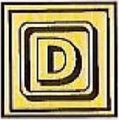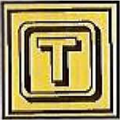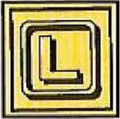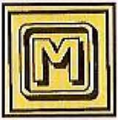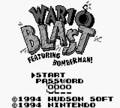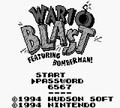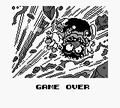Wario Blast: Featuring Bomberman!
It has been requested that this article be rewritten and expanded to include more information.
| Wario Blast: Featuring Bomberman! | |||
|---|---|---|---|
 North American box art | |||
| Developer | Hudson Soft | ||
| Publisher | Nintendo | ||
| Platform(s) | Game Boy | ||
| Release date | Template:Release | ||
| Genre | Action | ||
| Rating(s) |
| ||
| Mode(s) | Single player, 1-4 players simultaneous (Super Game Boy only) | ||
| Input | Game Boy:
| ||
Wario Blast: Featuring Bomberman! (Japanese: ボンバーマンGB, Bonbāman Gēmu Bōi) is a crossover game between the Wario franchise and Hudson Soft's Bomberman series that was released in 1994 and 1995 in North America and Europe, respectively. The game is a reskinned version of Bomberman GB, which was released in Japan in August 1994. The Wario series theme was exclusively added to Western releases. Aside from Wario's presence, the game is mostly unchanged and plays like other Bomberman titles. The Bomberman GB released in the West is actually the Japanese Bomberman GB 2.
The player takes the role of either Wario or Bomberman and fights against up to three copies of the other character. Wario's goal is to rob Bomberland, while Bomberman's is to protect it. In every round, the player has to defeat the enemies by strategically placing bombs, while the enemies are able to do the same.
Story

Story from the instruction booklet[1]
- WARIO INVADES THE LAND OF THE MADBOMBERS!
Wario, in his constant search for new lands to conquer and trea-
sures to gain, has found the extra-dimensional portal
that links his world with the one that Bomberman
inhabits. Thinking that the Madbombers will make a
nice addition to his legions of mindless minions (as
well as a new source of funds for his nefarious
schemes), Wario steps through the gate... and soon
finds that the Madbombers are not quite the dim-wit-
ted flunkies he originally thought them to be!
Gameplay
The player can choose to play as either Wario or Bomberman, but this does not change any aspects of gameplay, other than reversing the passwords for each level. There are eight rounds in total, including three regular levels and one boss level per round.
The game shares its objective with other Bomberman games. The player has to blow up between one to three opponent(s) via the use of bombs to advance, while they try to do the same to the player. The entire game is played from a top-down perspective. The player maneuvers around a grid-like playing field, setting off bombs to blow up unsuspecting enemies, and destroy walls to clear the way and to reveal occasional power-ups. The player wins by defeating the enemy Madbombers (which take on the appearance of the character not chosen). Every level is played with a best-of-3 rule. If the player wins two times, they gain access to the next level. Failure to do so results in a Game Over.
When playing the game on the Super Nintendo Entertainment System with a Super Game Boy, an additional multiplayer mode for up to four players is available, known as the Battle Mode.[2] In this mode, two or more players are able to play against each other, with up to four players being supported using the Super Multitap.
The game also contains a secret game mode called "The Battle" (not to be confused with the Battle Mode), available by entering the password 6565 on the title screen to play as Wario, or 5656 to play as Bomberman. Instructions on how to access this mode are never revealed in-game and can only be found through external information, such as a game guide. In this mode, the player starts with all power-ups, and the goal is to defeat endless waves of opponents to obtain a high score.
Bosses
At the end of each world, the player faces a boss. A certain strategy is required for each of them. The following list uses the names from Nintendo Power's coverage from the game in Volume 67, with the exception of Pukupuku and Gururin Knight, whose names come from the original game Bomberman GB.[3]
- World 1: Cup King
- World 2: Top Man
- World 3: T-Bear
- World 4: P-Flower
- World 5: Thunder Cloud
- World 6: Pukupuku
- World 7: Gururin Knight
- World 8: Mad-Bomber
Staff
- Main article: List of Wario Blast: Featuring Bomberman! staff
Development
At first, Mario was considered as the protagonist of the game, but there were concerns that having him use bombs to defeat his enemies would be out-of-character.[4] The development team pondered which Nintendo character who could feasibly use a bomb as a weapon and not be injured by its blast, eventually settling on Wario.[4] Even though Wario was a new character at the time, Nintendo sent the developers a list of approved and forbidden actions for the characters, which designer Norio Obuko likened to the approval process for using Disney characters in term of strictness.[4]
References in later games
Wario Blast: Featuring Bomberman! is not directly referenced in later games, but it began a trend in Nintendo spin-offs that associates Wario with bombs. Technically, bombs having any relevance to Wario first appeared in Wario's Woods, but in this game, they are solely used against him. Beginning in Mario Party, Wario has an association with Bob-ombs as his home stage, Wario's Battle Canyon, features the landscape of a canyon wrought with explosions from a war between Bob-ombs and Bob-omb Buddies, which Wario appears to be manipulating out of greed. In Mario Party 3, Wario's association with Bob-ombs continues, as one is his default partner in the game's duel mode. In Mario Tennis, Bob-ombs line the walls in Wario's home stage, Wario Court, as well as his joint venture with Waluigi, Wario & Waluigi Court. In Mario Kart: Double Dash!!, Wario's special item is the Bob-omb. In Super Mario 64 DS, Wario is one of the two characters who has a Bob-omb themed minigame in the Rec Room. In Mario Hoops 3-on-3, Wario's home stage Wario Factory has several Bob-ombs (ones larger than the Bob-omb one gets as an item) that appear as stage-exclusive hazards for the players. In Mario Super Sluggers, Wario hits a bomb in addition to a baseball as his special move. In the Club Nintendo comics, Wario is the owner of a bomb shop. Lastly, the timer and logo for the minigames in the WarioWare games is a bomb called the Bomb, with Wario's mustache on it.
Gallery
Artwork
- BombermanWB.png
- Mad Bomber Wario Blast.png
Sprites
Screenshots
The "The Battle" game mode
Miscellaneous
Media
Names in other languages
| Language | Name | Meaning | Notes |
|---|---|---|---|
| Japanese | ボンバーマンGB[?] Bonbāman Gēmu Bōi |
Bomberman GB |
References
- ^ Wario Blast: Featuring Bomberman! North American instruction booklet, page 4.
- ^ "Of course, what would a Bomberman game be without a Battle Mode?" — Wario Blast: Featuring Bomberman! North American instruction booklet, pages 4 and 5.
- ^ Bomberman GB (part of Bomberman Collection) at Hudson's Japanese website
- ^ a b c nori_bomber (Norio Obuko) on Twitter (February 27, 2021). Twitter. Retrieved February 28, 2021 (English translation by PushDustIn)
| Wario Blast: Featuring Bomberman! | |||
|---|---|---|---|
| Characters | Wario • Bomberman • Madbombers | ||
| Bosses | Cup King • Top Man • T-Bear • P-Flower • Thunder Cloud • Pukupuku • Gururin Knight • Mad-Bomber | ||
| Rounds | Normal Zone • Warp Zone • Arrow Zone • Fire Zone • Coma Zone • Ice Zone • Burn Zone • Power Zone | ||
| Normal Items | Explosion Expander • Extra Bomb • Skull | ||
| Special Items | Kicks • Dashin • The Trouncer • Liner • Moto | ||
| Objects | Block (Regenerating Wall) • Bomb • Bomb-Guiding block • Heated Vent • Warp Hole | ||
| Other | Bomberland • Staff • The Battle | ||
| Game Boy games | |
|---|---|
| Super Mario franchise | Alleyway (1989) • Baseball (1989) • Super Mario Land (1989) • Golf (1989) • Dr. Mario (1990) • Super Mario Land 2: 6 Golden Coins (1992) • Donkey Kong (1994) • Mario's Picross (1995) • Picross 2 (1996) |
| Donkey Kong franchise | Donkey Kong (1994) • Donkey Kong Land (1995) • Donkey Kong Land 2 (1996) • Donkey Kong Land III (1997) |
| Yoshi franchise | Yoshi (1991) • Yoshi's Cookie (1992) • Tetris Attack (1996) |
| Wario franchise | Wario Land: Super Mario Land 3 (1994) • Wario Blast: Featuring Bomberman! (1994) • Wario Land II (1998) |
| Miscellaneous | Tetris (1989) • The Legend of Zelda: Link's Awakening (1993) • Game & Watch Gallery (1997) • Game & Watch Gallery 2 (1997) |
